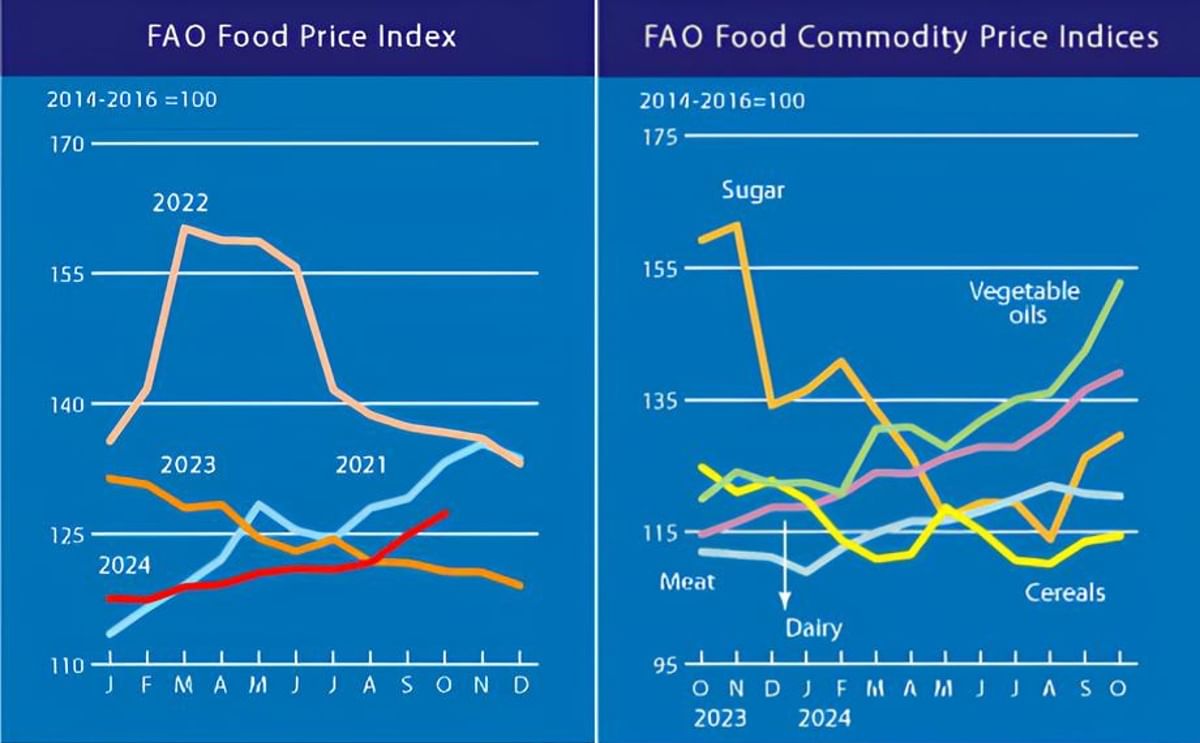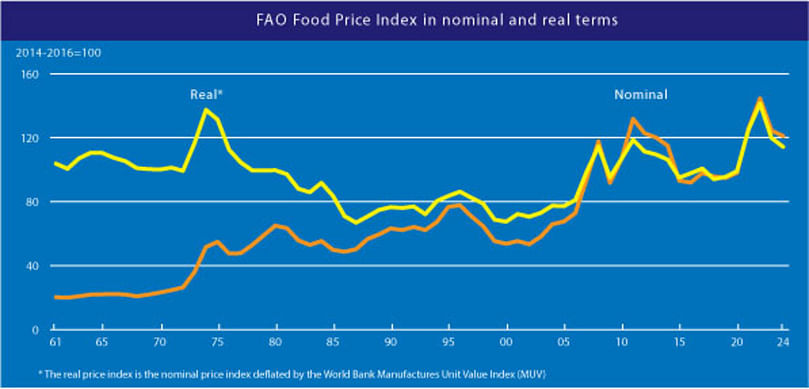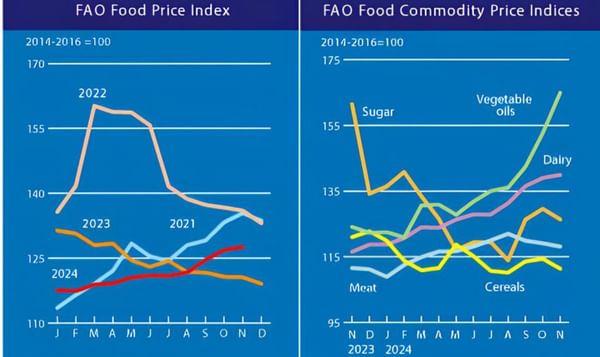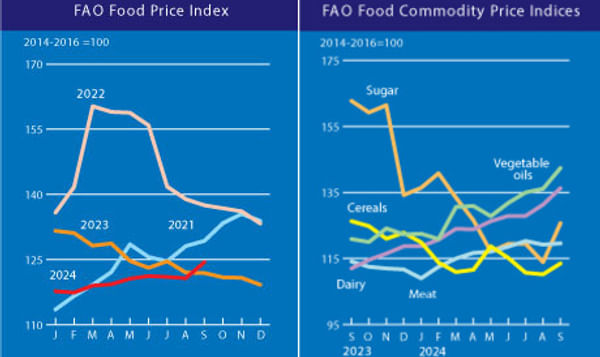Higher quotations across a range of commodities push the FAO Food Price Index to its highest level in 18 months
Higher quotations across a range of commodities push the FAO Food Price Index to its highest level in 18 months

The FAO Food Price Index (FFPI) averaged 127.4 points in October 2024, up 2 percent from its revised September level and the highest since April 2023. Price quotations for all commodities in the index, except meat, rose, with vegetable oils recording the largest increase at 7.3 percent. Compared to historical levels, the FFPI in October was 5.5 percent higher than its corresponding value a year ago but remained 20.5 percent below its peak of 160.2 points reached in March 2022.
The FAO Cereal Price Index averaged 114.4 points in October, up 0.9 points (0.8 percent) from September but still 10.3 points (8.3 percent) below its October 2023 value. Global wheat prices increased for the second consecutive month, mostly reflecting concerns over unfavourable weather conditions affecting winter crop sowing in several major northern hemisphere exporters, including the European Union, the Russian Federation and the United States of America.
Additionally, the re-introduction of an unofficial price floor in the Russian Federation and rising tensions in the Black Sea region exerted upward pressure on prices. World maize prices continued their upward trend in October, driven partly by strong domestic demand in Brazil and transport challenges in some parts of the country due to low river levels.
Dry conditions impeding planting in Argentina and steady demand for Ukrainian maize also contributed to the firmer tone. Among other coarse grains, world prices of barley rose, while those of sorghum declined. The FAO All Rice Price Index declined by 5.6 percent in October, reflecting lower quotations for Indica rice driven by expectations of increased competition among exporters following India’s removal of export restrictions on non-broken rice.
The FAO Vegetable Oil Price Index averaged 152.7 points in October, up 10.4 points (7.3 percent) from September and marking a two-year high. The rise was driven by higher quotations across palm, soy, sunflower and rapeseed oils. International palm oil prices increased for the fifth consecutive month in October, largely fuelled by concerns over lower-than-expected outputs coinciding with prospective seasonal production declines in key producing countries in Southeast Asia. Similarly, global sunflower and rapeseed oil prices continued to rise, mainly underpinned by prospects of subdued supplies due to lower expected production in 2024/25. World soyoil prices rose on firm global demand amid limited supplies of alternative vegetable oils.
The FAO Dairy Price Index stood at 139.1 points in October, up 2.5 points (1.9 percent) from September and 24.5 points (21.4 percent) higher than its value a year ago. International cheese prices registered the largest increase, reflecting limited availability of supplies to meet import demand for spot supplies amid strong internal sales, especially in the European Union, where milk production fell seasonally.
World butter prices also rose in October for the thirteenth consecutive month, driven by high internal demand, limited inventories, and seasonally low milk production in Western Europe. By contrast, price quotations for milk powders, especially skim milk powder, declined due to rising seasonal milk production in Oceania and weak global import demand.
The FAO Meat Price Index* averaged 120.4 points in October, down marginally (0.3 percent) from the revised September value and 8.4 points (7.5 percent) above its level a year ago. International pig meat prices fell the most, reflecting increased slaughter in Western Europe amid weak domestic and foreign demand. World poultry meat prices fell slightly, pressured by higher export supplies from major global producers. World ovine meat prices remained largely stable, as rising global demand offset a surge in new season supplies from Oceania. By contrast, international price quotations for bovine meat increased moderately, underpinned by stronger international purchases.
The FAO Sugar Price Index averaged 129.6 points in October, up 3.3 points (2.6 percent) from September and marking a second consecutive monthly increase, but still down 29.6 points (18.6 percent) from its value a year ago. Persisting concerns over the 2024/25 production outlook in Brazil, following a prolonged period of dry weather conditions, pushed sugar prices up in October.
Additionally, higher international crude oil prices, which stimulate a greater use of sugarcane for ethanol production in Brazil, further contributed to the increase in prices. However, the weakening of the Brazilian real against the United States dollar and improved precipitation in key southern growing areas of Brazil in late October limited the overall increase in world sugar prices.
* Unlike for other commodity groups, most prices utilized in the calculation of the FAO Meat Price Index are not available when the FAO Food Price Index is computed and published; therefore, the value of the Meat Price Index for the most recent months is derived from a mixture of projected and observed prices. This can, at times, require significant revisions in the final value of the FAO Meat Price Index which could in turn influence the value of the FAO Food Price Index.

FAO Food Price Index in nominal and real terms












